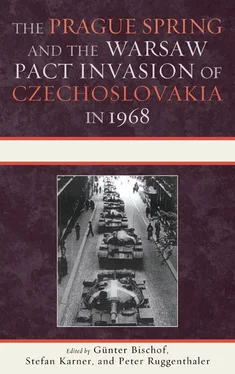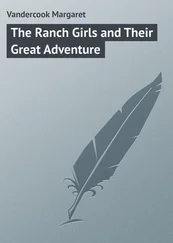After his 21 August statement to the American and world public, the president needed to brief his government and further consult with his advisers about the Czech crisis. He called a meeting of his cabinet for the afternoon of Thursday, 22 August, and left no doubt about his profound disillusionment with the Kremlin. The entire détente agenda was in question, and it was clear that the “Cold War was not over.” The Pentagon’s Clifford and the president agreed that the United States had no obligation to intervene militarily to help the people of Czechoslovakia, who did not seem to demonstrate a strong will for resistance. Rusk made it crystal clear that “if there were military intervention, there would be world war.” The secretary of state expressed his frustration with perceptions around the world that perceived superpower interventionism in Czechoslovakia and Vietnam to be the same thing. Washington continued to show grave concern over the repercussions of the invasion on West Germany and Berlin. 32
On the next day, Friday, 23 August, discussions continued with the president’s principal foreign policy advisers. Secretary of Defense Clifford noted that the Soviet military action was well planned and efficiently executed, yet politically disastrous. CIA director Helms expressed his concern that the crisis could spill over into Romania. The State Department advised putting pressure on Moscow via the United Nations (UN) and not NATO. NATO action would merely confirm the Soviet propaganda line of both NATO and a West German conspiracy against Czechoslovakia. 33In a meeting with Dobrynin, Rusk calmed him down with the observation that “in the atomic age the President is doing everything possible to diminish the potential for conflict.” 34Discussions in the Pentagon came back to the major conclusion that the Soviet action confirmed the importance of the U.S. presence in Europe. It killed all Congressional efforts to withdraw American forces and offered an opportunity to strengthen NATO. In the Pentagon’s analysis, the Warsaw Pact invasion of Czechoslovakia offered a great opportunity to strengthen the U.S. hegemonic position in Europe and improve NATO military force structures for future negotiations from strength—surely not what the Kremlin had envisioned as the U.S. response. 35
“ No action ”—Rusk’s earlier advice to Eugene Rostow’s entreaties to send warnings to Moscow—also defined the basic posture of the Johnson administration vis-à-vis the Warsaw Pact intervention in Czechoslovakia. Within forty-eight hours it was clear that the Johnson administration would not respond militarily to the renewed rape of Czechoslovakia. Washington never contemplated a military response for just one second and was forced to freeze—quite reluctantly—the entire spectrum of “bridge building” and détente activities with Moscow and the entire Soviet Bloc. Washington had learned the tough lessons of “Hungary 1956,” namely not to encourage premature rebellion with a propaganda onslaught to encourage senseless resistance by the Czechs and the Slovaks against overwhelming odds of crushing military power. Neither was the unleashing of covert operations seriously contemplated. The only pressure that could be exerted on the Soviets was via condemnation by the United Nations Security Council. The Johnson administration was quick to jump on the sudden opportunity to stop all Congressional talk of defense savings via American troop withdrawals from Europe and strengthen NATO and its crisis response scenarios. Washington’s main worry, however, became a possible spillover of the crisis to Romania, and maybe even Yugoslavia and farther into Central Europe.
WASHINGTON’S FEARS OF CZECH CRISIS SPILLOVER
Starting on 23 August, Washington’s growing anxiety that Romania might be next on the list of Soviet interventions captivated policymakers and diplomats for the next week. Nicolae Ceaus¸escu’s Romania had become a thorn in Moscow’s flesh with his growing emancipation from Kremlin control. Romania did not participate in the invasion of the “Warsaw Pact Five” (Soviet Union, Poland, Bulgaria, Hungary, German Democratic Republic); its official protest launched against its allies’ invasion of Czechoslovakia was even more galling. 36On 23 August, CIA director Helms warned against a Soviet troop buildup on Romania’s borders. Rumors of an imminent Soviet invasion seemed to have mainly originated from Romanian sources. The U.S. military attaché in Hungary visited the border areas and could not detect any massive troop build-ups vis-à-vis Romania or Yugoslavia. 37Soviet expert George Kennan, vacationing in Scandinavia, commented on the stark difference between Czechoslovakian and Romanian behavior: while the Czechs had been faithful to their alliance commitments, the Romanians had abused them. 38
Secretary of State Rusk worried greatly about an escalating threat toward Romania. He did not want to take any chances and ordered his “Czechoslovakia Task Force” to initiate contingency planning for Romania as well. NATO headquarters, too, monitored Warsaw Pact troop movements toward the Romanian borders and Yugoslavia’s mobilization of reservists carefully. 39Rusk also issued repeated warnings to Ambassador Dobrynin. He warned him that an invasion of Romania would have devastating consequences for U.S.-Soviet relations and world politics. Dobrynin pooh-poohed all the unsubstantiated rumors flying around Washington about Soviet threats toward Romania. On 29 August, Rusk again called in Dobrynin to the State Department after the plot of Soviet troop movement toward and border incidents vis-à-vis Romania seemed to thicken. He warned the Soviet ambassador that an intervention in Romania would produce “incalculable risks” in world politics. Rusk added: “Any move against Berlin would be ‘ of utmost gravity ’” (emphasis mine). 40W. W. Rostow summarized State Department and CIA analyses of a threat to Romania for the vacationing president in Texas. The State Department resident Soviet expert Charles Bohlen and U.S. ambassador in Moscow Llewelyn Thompson calculated that chances for a Soviet invasion were 30 percent for and 70 percent against. The CIA presented an “inconclusive” general picture. 41President Johnson still took the opportunity to send a clear warning to Moscow in a speech the next day in San Antonio, Texas. He obliquely warned against the prospect of aggression against Czechoslovakia being repeated elsewhere in Eastern Europe, yet put Moscow unmistakably on notice: “ So, let no one unleash the dogs of war ” (my emphasis). Dobrynin quickly reassured Rusk again that Moscow had no military plans vis-à-vis Romania. 42Johnson’s warning clearly registered in the Kremlin. Even though rumors about Soviet movement vis-à-vis Romania continued to persist throughout the entire month of September, frequently stoked by Romanian diplomats, the danger slowly abated in the course of the fall.
Wild rumors also circulated about a Soviet threat toward Yugoslavia at the same time. 43Josip Broz Tito’s Yugoslavia had also officially condemned the Warsaw Pact action against Czechoslovakia and allowed thousands of Czechoslovak vacationers on the Adriatic beaches to stay, some of them free of charge. Soviet counter-propaganda produced “a full-blown war scare” in Yugoslavia. Tito ordered some defensive measures, but did not alarm the world with a general mobilization. Rusk asked the Yugoslav ambassador to keep him informed about Soviet maneuvers and castigated Soviet “black propaganda.” He expressed regrets over the damage done to détente and bridge-building in Eastern Europe by the Warsaw Pact intervention. Rusk assured Ambassador Crnobrnja that unlike Hungary 1956, the CIA had not unleashed any covert military infiltration in Czechoslovakia. Clearly, unlike President Eisenhower’s overheated rhetoric of “rolling back” communism, the Johnson administration practiced a traditional containment policy and respected the Soviet sphere of influence. 44
Читать дальше












